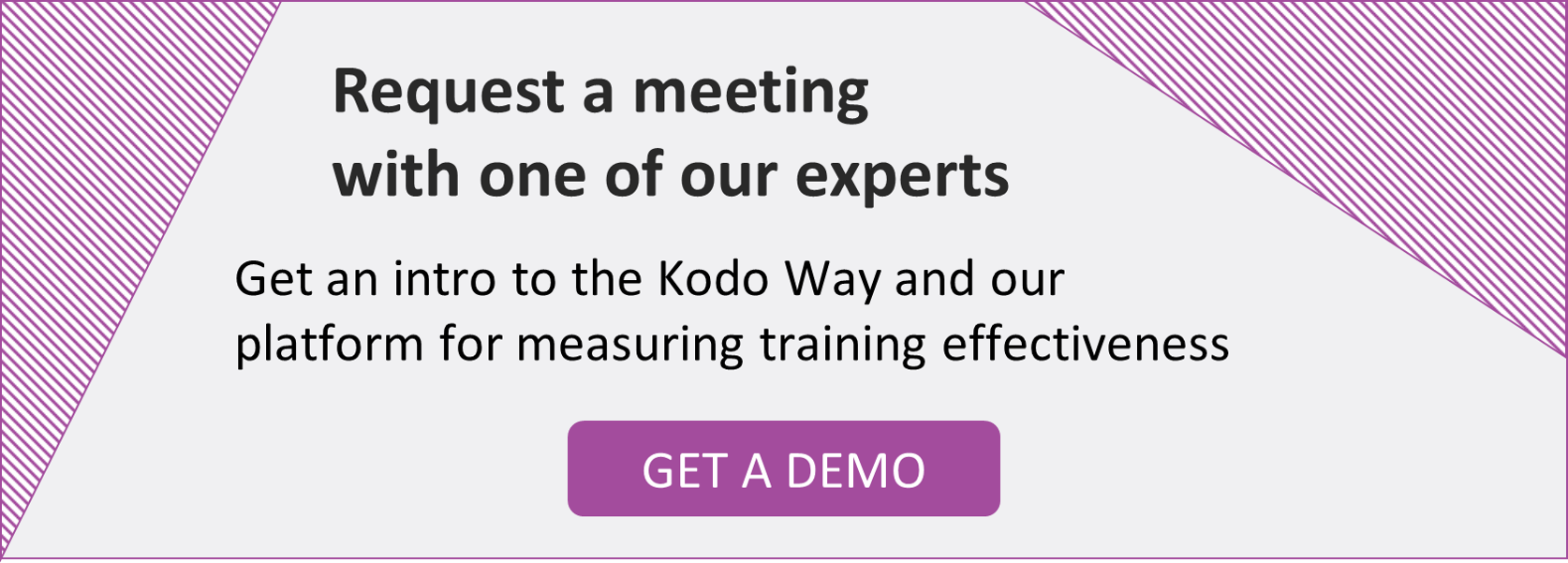
In our last post, we offered a complete beginner’s guide to learning transfer in 2019. If you are responsible for selecting or implementing training in your organization, you may be wondering about your next steps.
To help you bring the gap between your organization’s learning initiatives and its business outcomes, we’ve put together a comprehensive start-to-finish guide to learning transfer. We’ll outline the entire process, from choosing a methodology to selecting the learning transfer strategies and measuring the results.
If you’re looking to measure on-the-job changes that resulted from training and prove the value that training brings to an organization, read on.
Step 1: Choose a methodology
Step 2: Understand the methodology
Step 3: Conduct training evaluation
Step 4: Measure learning transfer
Step 5: Select learning transfer activities
Step 6: Choose and implement learning transfer activities
.
Our six-step, start-to-finish guide will get you up to speed on learning transfer in no time.
Step 1: Choose a methodology
The main purpose of corporate training is to help people develop skills, attributes and behaviors that enhance their on-the-job performance and, by exception, the performance of the organization they work for.
There are many methodologies that help measure the effectiveness of training courses. However, most popular models focus on measuring learning and not on measuring performance outcomes.
Why is this important?
Research indicates that only 15-20 percent of learning actually results in work performance changes. What’s more, research from Saks and Belcort showed that the use of learning actually declines over time.
This suggests that training doesn’t create performance change at an acceptable rate and this is where learning transfer is helpful.
The purpose of learning transfer is to measure the rate of change and work to improve it. To measure learning transfer, you need a methodology; a set of rules, tasks, and activities that you have to follow and implement in order to track learning transfer.
Some of the main methodologies you may choose include:
- The Kirkpatrick Model is a popular four-level model that evaluates training according to stakeholder expectations.
- The Phillips ROI Model adds a fifth level to the Kirkpatrick model and measures return on investment (ROI) of training.
- The Kaufman Model also adds a fifth level to Kirkpatrick and aims to evaluate the impact of the training on both the organization’s customers and on society.
- The CIRO model is specifically aimed at evaluating management training.
- The Brinkerhoff Model (or the Success Case Method) aims to show how well a corporate training works and why it is working.
- The Anderson model of learning evaluation (the Value of Learning Model) focuses on aligning an organization’s training programs with its strategic priorities.
Each of these methodologies has its own unique set of advantages and drawbacks but at their core, they have the same basic goal: to measure learning transfer and help business determine the link between training initiatives and specific business outcomes.
Choosing the right methodology will depend on a range of factors including:
- The type of training
- The size of your organization
- The timeframe
- The budget
So, how do you choose the right approach?
Read the main goal of each methodology and find the one that is most closely aligned with your organization's goals:
If you want to measure the learning transfer for a management training course, the CIRO model may be a good fit.
If you want to know the ROI of your training course, the Phillips ROI Model may be useful.
If you don’t have the time or budget for an ROI analysis, the Kirkpatrick Model may be easier to implement.
Step 2: Understand the methodology
Once you have chosen your preferred evaluation model, your next step is to take time to understand how it works.
Depending on the size of your organization and your available timeframe and budget, you may enlist employees to conduct the training evaluation, or you may hire a trained evaluator or a Trainer Observer to implement the model for you.
Regardless of your approach, you should still have a working understanding of your chosen methodology. This will help you understand what it can and can’t do.
For the purposes of this guide, we’ll focus on the Kirkpatrick model of training evaluation as it’s by far the most popular and commonly used methodology for measuring training effectiveness.
If you’re new to Kirkatprick, it has four specific levels of assessment:
Level 1: Reaction
Level 2: Learning
Level 3: Behavior
Level 4: Results
Here, we’ll briefly explain how the model is applied.
Level 1: Reaction
After the training has finished, you ask participants to complete a short survey or questionnaire. The purpose of this evaluation is to guage their reaction to the training.
You may ask questions such as:
What did you think of the trainer?
How was the venue?
Was the class or group size acceptable?

Level 2: Learning
The second level of evaluation measures the learning that took place. There are many approaches, including asking the participants to complete a short test or quiz or asking them to perform a manual test or task. The purpose of this level is to measure the learning that took place.
Level 3: Behavior
The Kirkpatrick Models’ third level of evaluation takes place a while after the training has wrapped up. You assess whether what the participants learned has made its way into the workplace. Workplace observations appraisals are common level 3 evaluation approaches.
Level 4: Results
The final Kirkpatrick level is results. This level looks at whether the training produced any behavioral changes and measures them against the stakeholders’ expectations. In other words, did the training accomplish what key stakeholders in the organization wanted it to?
Once you have a working understanding of the benefits and drawbacks of your preferred methodology, you’re ready to start implementing it.
Step 3: Conduct training evaluation
As we discussed, responsibility for conducting training evaluation may be assigned to employees, or you may hire third-party experts such as trained evaluators to carry out assessments for you.
So which approach is right for you?
The complexities of measuring learning transfer depend largely on the nature of the learning that has taken place.
For example, if the training focuses on manual tasks that are simple to observe and measure, learning transfer will be easier to assess. A training course that helps operators work a new piece of machinery will be easy to assess; workers have either mastered the skills necessary to work the machine or they haven’t.
However, the learning transfer for training that focuses on more abstract, less-easily measure concepts such as leadership skills, communication skills or cultural awareness is far more difficult to measure and assess. For instance, a manager may successfully complete a leadership training course, yet their learning would take time to be implemented. It may take a while before behavioral, on-the-job changes are noticeable.
Step 4: Measure the learning transfer
In this guide, we’re using the example of the Kirkpatrick Model to show how to measure learning transfer. As we discussed, this model compares learning results with stakeholder expectations.
As an example, let’s say that the stakeholders of a call center intended that a particular training course would help employees handle more calls per hour. After running the training, you would start implementing the Kirkpatrick model.
Here are some activities for each level:
Level 1: Reaction
You hand out reaction surveys to the call center employees who completed the training course.
Level 2: Learning
You ask employees to complete a short practical test that measures their call handling ability. By comparing their results with their pre-training results, you could show that learning has taken place. In other words, they can handle more calls per hour before the training after the training than before.
Level 3: Behavior
Following the Kirkpatrick model, you would conduct a workplace assessment a couple of months after the training had finished. You could conduct peer observations or supervisor assessments to see how the operators were performing, or you could look at call records to calculate the average call handling rate.
Level 4: Results
In the final stage, you would look at the learning and behavior results and compare them against the stakeholders’ expectations. Had the training resulted in the call center employees being able to handle more calls per hour?
To measure the learning transfer, you could dig into the data and show the percentage by which employees had improved, or, the average rate of improvement. This would show you the extent to which the training had been successful.
Step 5: Select learning transfer activities
Once you have established the rate of learning transfer, you can use a learning transfer activity to increase the return-on-investment of the training. Such activities can have a significant impact on an organization’s performance as can have a tremendous impact on the effectiveness of learning.
Learning transfer activities can be grouped into three main categories:
- Learner readiness
These activities focus on helping the learner prepare for learning, such as providing motivation, helping them set learning goals and testing. - Learning transfer design
These activities help inform the design of the training, such as practice activities, support, application review, and role modeling. - Operational alignment
These activities help an organization support its employees in using their newly acquired skills, attributes and behaviors, such as peer support, coaching, and creating a learning culter.
Each of these three areas contains specific activities that you can select. Let’s look at each area in more detail.
1. Learner readiness activities
This category has four specific activities that you can use to boost learning transfer by preparing the learners to learn. Overall, these activities can boost learning transfer by more than 70 percent.
- Self-efficacy activities
These types of activities help address learners’ belief in their own ability to learn. - Learning motivation activity
Activities such as addressing learning anxiety, helping people appreciate the value of learning and promoting a love of lifelong learning fall into this category. - Career goal alignment activities
Activities that help learners see the skills as valuable to their career progress are more likely to boost learning transfer, as the learner will see their value and usefulness. - Intent to use activities
These activities help learners practice the skills they learn and focus on how to integrate news skills with their work.
2. Learning transfer design
The design of the learning process is extremely important. There are three activities in this category that you can use to boost learning transfer.
- Application review
Research has found that extending the learning beyond the initial training event can help boost learning transfer rates. For example, you could offer content reviews or practical demonstrations of how to apply a skill to specific work tasks.
- Learning goal setting
Asking participants to set specific goals for their learning increases the chances that they will use the skills during their daily work. - Practicing and modeling
The more opportunities for practice that a training course offers, the greater the learning transfer rate will be.
3. Operational alignment
This category has three main learning transfer activities that can help boost the results of a training course.
- Learning culture
Organizations that have a strong learning culture where changes are readily accepted and embrace are far more likely to see high learning transfer rates from their training courses. - Peer support
Research has shown that encouraging peer support has a very high impact on learning transfer rates. - Manager support and coaching
Organizations with managers that are trained to support and coach the skills their staff learn have a far higher learning transfer rate for training compared with those that don’t.
Step 6: Choose and implement learning transfer activities
Your final step is to select specific learning transfer activities, depending on your goal, or which areas of improvement you have identified.
How?
Using data from the Kirkpatrick model assessment, you could pinpoint where your employees were struggling.
For example, if the Level 2 (Learning) results were weak, you could summarize that Learner readiness needs to be improved. You could focus on learning transfer activities such as self-efficacy, motivation to learn, intent to use, or career goal alignment to help prepare your employees to learn, both emotionally and psychologically.
But what if the Level 2 Learning results were good, and the Level 3 Behavior results showed that training didn’t result in on-the-job changes? The problem could lie in learning transfer design. Your employees could need more help with things like practice and modeling, goal setting and application review to help them implement the new skills, behaviors, and competencies they acquired during training to their workplace environment.
Another possibility is that the problem lies with operational alignment. Maybe there isn’t the support in place for employees to use their learning on the job. In this case, you may look at activities such as management support and coaching, as well as peer support to help boost learning transfer rates.
Conclusion
If you were looking for a start-to-finish guide to learning transfer, that’s about it.
There is convincing evidence that learning transfer activities can improve the performance results that you achieve from training, compared with just running the training alone. The key is understanding the pain-points that your employees are experiencing and finding the right learning transfer activities to meet their needs.
Related posts

